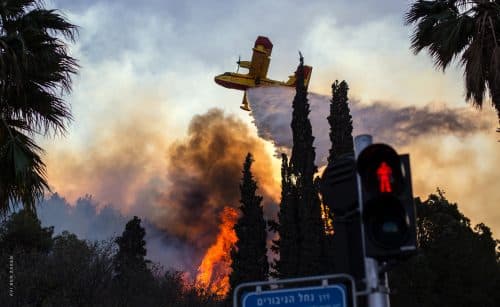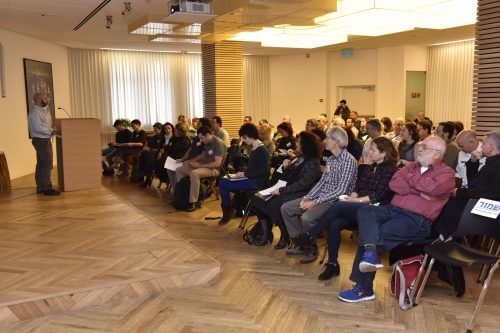A special committee of experts gathered in the Haifa municipality to discuss the prevention of fires and the reduction of their damage in forested urban areas. This is a joint initiative of the Israeli Association for Ecology and Environmental Sciences, the Technion, the Israeli Union of Landscape Architects and the municipality.

Last week, a committee of experts gathered in the Haifa municipality to prevent fires in urban forest and forest areas and to reduce their damage. About 70 experts from a variety of fields participated in the event, including ecology and nature, firefighting, landscape architecture, society and community. The committee, which convened following the burning of the Giant in Haifa in November 2016, is a joint initiative of the Israeli Association for Ecology and Environmental Sciences, the Technion, the Israeli Union of Landscape Architects and the Haifa Municipality.
At the event, the best experts were invited to propose ideas that dealt with three main issues: the restoration of the burned areas, the planning and management of the existing green areas, and the planning and management of the interface between the built-up area and the open area. Following the meeting, a summary document will be submitted to the Haifa Municipality that will be used by the decision makers and the residents.
Hadva Almog, Deputy Mayor of Haifa, thanked all the parties who joined in the establishment of the committee and said: "Haifa went through a severe trauma four months ago. We started the restoration the very day after the fire, first by responding to the affected families and later by restoring the green landscape that characterizes the city. The current collaboration will result in a pooling of resources and professional knowledge, and the team of experts will be able to use the master plan for the wadis that we recently completed and within the framework of which all the wadis were mapped and recommendations were made for their treatment."
The dean of the Faculty of Architecture and Urban Planning at the Technion, Prof. Iris Aravat, said that "the banner of the Technion regarding the fire, and in general, is 'with the city, with the community' - exactly the opposite of the concept of the Ivory Tower. We promote citizen science - science related to the field and the community. The initiative at the Technion, which arose in our faculty already a week after the fire, received the blessing of the Technion president and his support, which allowed us to begin a joint effort of faculty members and students to study the subject and begin formulating conclusions and ideas for the future."

Prof.-member Tal Alon Mozes, head of the landscape architecture track at the Technion, emphasized the importance of the integrative landscape discussion following the fire. According to her, "the fire is an opportunity to change fixed perceptions about the beautiful and proper in the urban landscape in favor of new perceptions. These see the fire as part of natural processes, find the beautiful in the green that emerges from the black, and the unique in the gradual processes of change and restoration rather than trying to restore an idyllic landscape image overnight."
Dr. Eran Brockowitz, the outgoing scientific director of the Israeli Association for Ecology and Environmental Sciences, said: "The goal of the expert committee is to combine forces between the various bodies - academia, municipality, firefighting and other interested parties - and start formulating recommendations. It is important that this be the beginning of a process that will lead to practical recommendations for preventing and treating fires."
"Beyond the preservation of nature's values, it is important to remember that nature provides us with enormous services - reducing air and water pollution, flood regulation and physiological, mental and social benefits," said urban ecologist Dr. Assaf Schwartz, a faculty member in the Faculty of Architecture and Urban Planning at the Technion. "However, it is clear that urban vegetation, which contributes so much to us, also endangers us. Therefore, an informed action is needed that will preserve the urban nature but reduce the risks."
"Before the fire in November, the National Fire and Rescue Authority received a serious warning from the meteorological service - a warning about the possibility of fires developing as a result of extreme weather that included easterly winds, low humidity, dryness and a heat wave," said Yitzhak Suisa, deputy commander of the Haifa fire station and formerly responsible for buffer and forests . "It is important to understand that for us, as firefighters, human life comes before other damages. In the fire in question, we realized very quickly that this was an extreme and dangerous case, so we focused first on saving lives and only then on the issue of property. What we need is significant cooperation between the various bodies and between them and the residents."
See more on the subject on the science website:

One response
The solution is Chaitz paths between forests and between settlements in the forests.
Such a simple solution and it has already been talked about several times, Keren Kemayet implements it in all its forests, but the Gardens and Landscape Authority is not ready to implement it, they prefer everything to burn, just not to build Chaitz paths.